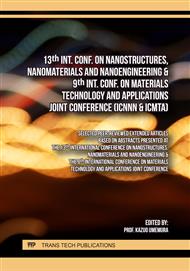[1]
R. Geyer, J. R. Jambeck and K. L. Law. Sci. Adv. 3 (7), (2017).
Google Scholar
[2]
D. K. A. Barnes, F. Galgani, R. C. Thompson and M. Barlaz. Philos. Trans. R. Soc. Lond. B Biol. Sci. 364 (1526), 1985–1998, (2009).
Google Scholar
[3]
M.P. Aji, A.L. Wati, A. Priyanto, J. Karunawan, B.W. Nuryadin, E. Wibowo, P. Marwoto and Sulhadi. Environ. Nanotechnol. Monit. Manag. 9, 136–140 (2018).
DOI: 10.1016/j.enmm.2018.01.003
Google Scholar
[4]
A.N. Uttaravalli, S. Dinda, B.R. Gidla. Process Saf. Environ. Prot. 137, 140–148 (2020).
Google Scholar
[5]
M.K. Houtchens Toxic Encephalopathies II: Leukoencephalopathies. In Clinical Neurotoxicology; Elsevier: (2009); p.88–96.
DOI: 10.1016/b978-032305260-3.50014-9
Google Scholar
[6]
Information on https://www.osha.gov/chemicaldata/462
Google Scholar
[7]
H. Park, D. J. Shin and J. Yu. J. Chem. Educ. 98 (3), 703–709, (2021).
Google Scholar
[8]
Y. Huo, S. Xiu, L.-Y. Meng and B. Quan. Chem. Eng. J. 451, 138572, (2023).
Google Scholar
[9]
X. Qin, X. Wang, H. Xiang, J. Xie, J. Li and Y. Zhou. J. Phys. Chem. C 114 (39), 16806–16812, (2010).
Google Scholar
[10]
Z. Zhang, S. Song, Y. Ding, J. Yu, W. Wu, J. Li, X. Wang, Y. Guo and L. Gong. J. Colloid Interface Sci. 669, 816–824, (2024).
Google Scholar
[11]
D. Saha and M.J. Kienbaum. Microporous Mesoporous Mater. 287, 29–55, (2019).
Google Scholar
[12]
M.A. Sheikh, R.S. Chandok and A. Bashir. Carbon Letters. (2024).
Google Scholar
[13]
L.W. McKeen Styrenic Plastics. In Effect of Temperature and Other Factors on Plastics and Elastomers (p.41–95). Elsevier, (2008).
DOI: 10.1016/b978-081551568-5.50004-9
Google Scholar
[14]
Y. Dang, B. Li, X. Feng, J. Jia, K. Li and Y. Zhang. ChemPhotoChem 7 (2), (2023).
Google Scholar
[15]
M. Yang, H. Li, X. Liu, L. Huang, B. Zhang, K. Liu, W. Xie, J. Cui, D. Li, L. Lu, H. Sun and B. Yang. J. Nanobiotechnol. 21(1), 431 (2023).
Google Scholar
[16]
C.S. Stan, A. Coroabă, E.L. Ursu, M.S. Secula and B.C. Simionescu. Sci. Rep. 9(1), 18893 (2019).
Google Scholar
[17]
N. Papaioannou, A. Marinovic, N. Yoshizawa, A.E. Goode, M. Fay, A. Khlobystov, M.-M. Titirici and A. Sapelkin. Sci. Rep. 8(1), 6559 (2018).
DOI: 10.1038/s41598-018-25012-8
Google Scholar
[18]
R.C. Powles, N.A. Marks and D.W.M. Lau. Phys. Rev. B 79(7) (2009).
Google Scholar
[19]
S. Ghosh, A.M. Chizhik, M.O. Dekaliuk, J. Enderlein, H. Schuhmann, M. Seibt and A.I. Chizhik. Nano Lett. 10(14), 5656–5661 (2014).
DOI: 10.1021/nl502372x
Google Scholar
[20]
M. Ghorbanpour, A. Feizi. J. Water Environ. Nanotechnol. 4(1), 60–66 (2019).
Google Scholar
[21]
J.-W. Luo, A. Franceschetti and A. Zunger. Nano Lett. 8(10), 3174–3181 (2008).
Google Scholar
[22]
Swathilakshmi and S. Anandhan. Sensors Diagn. 1(5), 902–931 (2022).
Google Scholar
[23]
H. Ding, X.-H. Li, X.-B. Chen, J.-S. Wei, X.-B. Li and H.-M. Xiong. J. Appl. Phys. 127(23) (2020).
Google Scholar
[24]
E.M. Santos, W. Sheng, R. Esmatpour Salmani, S. Tahmasebi Nick, A. Ghanbarpour, H. Gholami, C. Vasileiou, J.H. Geiger and B. Borhan. J. Am. Chem. Soc. 143(37), 15091–15102 (2021).
DOI: 10.1021/jacs.1c05039
Google Scholar
[25]
X. Zhang, Y. Liu, C.-H. Kuan, L. Tang, T.D. Krueger, S. Yeasmin, A. Ullah, C. Fang and L.-J. Cheng. J. Mater. Chem. C 11(34), 11476–11485 (2023).
DOI: 10.1039/d3tc02209a
Google Scholar
[26]
J.K. Radhakrishnan, M. Kumara and Geetika. Sensors Int. 2(100059), 100059 (2021).
Google Scholar
[27]
Q. Zhou, W. Chen, L. Xu, R. Kumar, Y. Gui, Z. Zhao, C. Tang and S. Zhu. Ceram. Int. 44(4), 4392–4399 (2018).
Google Scholar
[28]
C. Özbek, S. Okur, Ö. Mermer, M. Kurt, S. Sayın and M. Yılmaz. Sensors Actuators B: Chem. 215, 464–470 (2015).
DOI: 10.1016/j.snb.2015.04.004
Google Scholar
[29]
P. Kumar, Samiksha, Shalini and R. Gill. Asian J. Chem. 30(12), 2737–2742 (2018).
DOI: 10.14233/ajchem.2018.21574
Google Scholar



